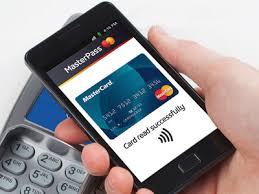The Opportunity And Risk Of Contactless Mobile Payments
 The use of contactless mobile payment platforms like Apple Pay, My Starbucks, Samsung Pay and Google's Android Pay - to name but a few - could grow in popularity by more than a stunning 200% in 2016. It's easy to see why. These new platforms - especially those offered by popular and global brands - are often installed by default on smartphones and quick and easy to set up and use: all it takes is a quick tap or wave in front of a card reader for payment to be made.
The use of contactless mobile payment platforms like Apple Pay, My Starbucks, Samsung Pay and Google's Android Pay - to name but a few - could grow in popularity by more than a stunning 200% in 2016. It's easy to see why. These new platforms - especially those offered by popular and global brands - are often installed by default on smartphones and quick and easy to set up and use: all it takes is a quick tap or wave in front of a card reader for payment to be made.
International auditors and financial management consultancy, Deloitte, is also predicting a potential growth of 150% in "touch commerce". This is where a customer logs on to a website or app and makes a payment using their smartphone, authorizing the transaction with a fingerprint or a few touches of the screen. There's no need to be in-store or near a card reader. All this growth even though ecommerce shopping cart abandonment rates can be as high as 80%.
What's driving this growth?
Consumers are fast becoming used to the idea of using their debit or credit cards and smartphones to make quick and small payments without entering a PIN. They want and like the convenience. Trusting the technology is a concern but when uber-cool brands like Apple build contactless payment apps into their phones and watches, trust is transferred. Starbucks too is on to something. Their payment app doubles up: it's a payment and loyalty app. Combining the two things integrates paying for a good with a reward, driving its value and adoption.
As Forbes points out, more and more payment apps will likely be included by default into the latest models of smartphone too, further enabling consumers to become familiar and comfortable with using them. Barriers to adoption are being removed by the day it seems: preloaded, mobile, contactless. It sounds enticing.
The impact
Whether it's people tapping or waving their smartphones at a card reader in-store, or a touchless online payment, these seamless ways to pay represent an opportunity for all businesses. Enabling customers to use them might deliver better sales results, higher levels of customer loyalty and brand appeal. But there's a risk: in the rush to meet consumer demands for convenience, caution shouldn't be cast aside.
Tony Anscombe, Senior Security Evangelist for AVG Business, provider of online security solutions for businesses worldwide, gives a clear warning, "Contactless payments could become the new frontline in the battle against mobile hacking and fraud as it provides cybercriminals with the potential for direct monetization."
It's a timely and important message. This year's Mobile World Congress will be discussing the opportunity of remote payments in earnest, and concerns about payment security will no doubt be high up the agenda.
Don't think it can't happen to your business
Anscombe continues, "No matter which payment platform emerges as the leader, or which one a business chooses to offer its customers, cyber criminals will try to hack them all. They'll try to hack the businesses and consumers using them, looking for methods to intercept or generate fraudulent transactions. If they're particularly bold, they may even attempt to hold a business - even a small one - to ransom. Only last year, a hacker froze access to a Scottish hairdresser's list of customer appointments until they paid up."
Don't underestimate the power of convenience
The risk of being hacked should be enough to make any business think twice about adopting any new payment system. However, eventually businesses might have little choice but to bow to consumer demands for the convenience of contactless mobile payments. If a business doesn't, consumers will simply switch to a competitor who does.
What next?
So how should a business go about implementing a contactless payment system? The answer will depend on the nature of the business as much as the nature of its customers, not to mention the cultural, commercial and legal environment in which the business operates. That said, some of the key issues most businesses will need to discuss include:
- Deciding which contactless platforms customers will want, and when and where they will need to be deployed: in-store, online or both?
- Understanding how those platforms will technically integrate with existing payment transaction and accounting systems, consumer pay points, order processing and what that means for security.
- Deciding how the business will incorporate payment with customer rewards or other business offerings.
- Defining how to communicate the new payment option to consumers, answer their questions about how it can be used and resolve their security concerns.
- And last but by no means least: the logistics and costs of making those changes need to be established, as well as a clear understanding of the return on investment.
Contactless is here to stay
It's going to grow and potentially become the preferred way people pay for many goods and services over the coming years. Security concerns aren't going to disappear but convenience will probably win out the day. So there's a clear opportunity, if not an immediate need, for businesses to meet that demand and adapt how they invite their customers to pay.
Tony Anscombe is a Senior Security Evangelist for AVG Business

 Delicious
Delicious Digg
Digg StumbleUpon
StumbleUpon Propeller
Propeller Reddit
Reddit Magnoliacom
Magnoliacom Newsvine
Newsvine
Comments
Post new comment